Dive into the heart of Croatia’s culinary tradition with our roundup of 20 Authentic Croatian Recipes that promise to transport your taste buds straight to the Adriatic coast! Whether you’re craving the comfort of a hearty Peka or the fresh zest of Dalmatian Brudet, these dishes are perfect for home cooks looking to spice up their meal rotation with something deliciously different. Let’s get cooking!
Dalmatian Pasticada
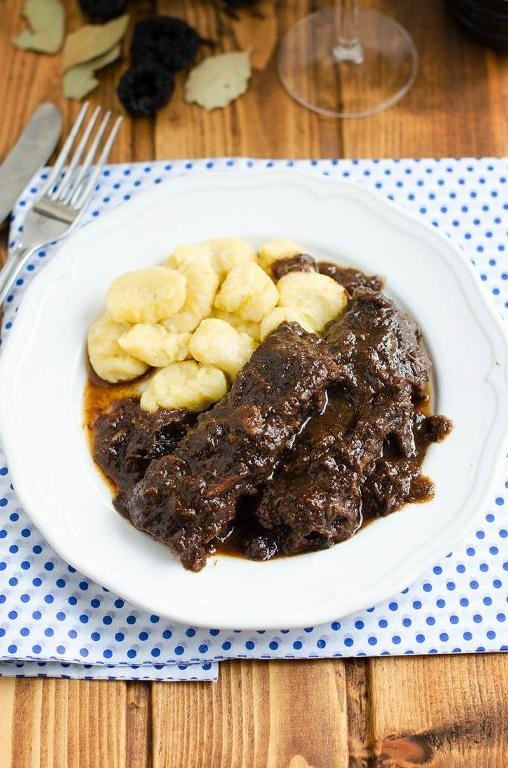
So, you’ve decided to dive into the world of Dalmatian Pasticada, a dish so rich in flavor it could probably write its own love story. This Croatian gem is like the slow dance of beef and red wine, with a symphony of spices that’ll make your taste buds sing.
Ingredients
- 3 lbs beef round (go for a cut that’s marbled like a masterpiece)
- 2 cups dry red wine (because the beef deserves a good drink too)
- 1/2 cup extra virgin olive oil (my kitchen’s liquid gold)
- 4 cloves garlic, minced (no vampire parties here)
- 2 onions, finely chopped (tears are optional but likely)
- 2 carrots, diced (for a sweet little crunch)
- 2 celery stalks, diced (the unsung hero of flavor)
- 1 tbsp tomato paste (the secret handshake of richness)
- 1 tsp cloves (a pinch of mystery)
- 1 tsp nutmeg (because why not?)
- Salt and pepper to taste (but let’s be generous, shall we?)
Instructions
- Marinate the beef in red wine overnight in the fridge. Patience is key here, like waiting for your favorite band to go on stage.
- Heat olive oil in a large pot over medium heat. Brown the beef on all sides until it’s got a crust that would make a pirate jealous. Remove and set aside.
- In the same pot, sauté garlic, onions, carrots, and celery until they’re softer than your favorite pillow. Tip: Don’t rush this step; it’s the foundation of flavor.
- Stir in tomato paste, cloves, and nutmeg, cooking for 2 minutes until fragrant. Your kitchen should smell like a Croatian grandmother’s hug.
- Return the beef to the pot, add the marinade, and bring to a simmer. Cover and cook on low heat for 4 hours, or until the beef is tender enough to cut with a spoon. Tip: Check occasionally to ensure it’s not drying out; add water if needed.
- Season with salt and pepper. Serve over gnocchi or mashed potatoes for a carb-loaded embrace. Tip: Let it rest for 10 minutes before serving to let the flavors marry like a well-planned wedding.
When you finally take that first bite, the beef should melt in your mouth like butter on a hot summer day, with a sauce so rich and complex it’ll have you plotting your next visit to Dalmatia. Pair it with a glass of the same red wine you cooked with, because what’s a love story without a little romance?
Istrian Stew
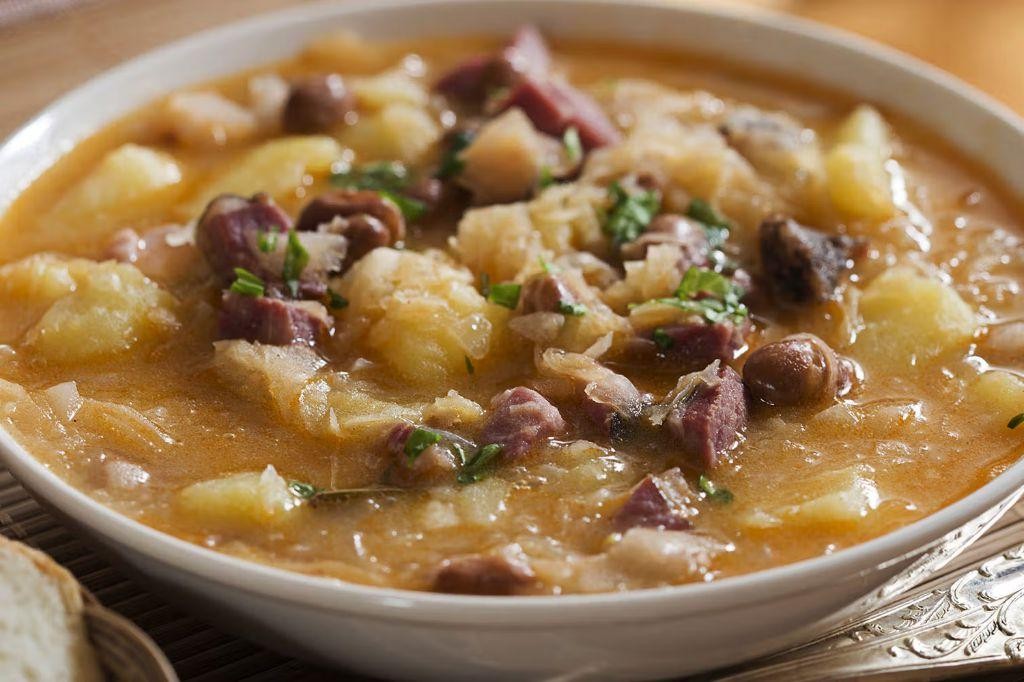
Venture into the heart of Istria with this stew that’s as hearty as a Croatian fisherman’s handshake. Packed with flavors that’ll make your taste buds dance the kolo, it’s the perfect dish to warm your soul and impress your dinner guests.
Ingredients
- 2 lbs beef chuck, cut into 1-inch cubes (because bigger is always better, right?)
- 1 large onion, diced (tears are optional but likely)
- 3 cloves garlic, minced (fresh is best, unless you’re a vampire)
- 2 tbsp extra virgin olive oil (my go-to for that golden sear)
- 1 cup dry red wine (choose one you’d drink, the stew deserves it)
- 2 cups beef broth (homemade if you’re fancy, store-bought if you’re human)
- 1 tbsp tomato paste (the secret umami booster)
- 1 tsp smoked paprika (for that whisper of mystery)
- Salt and freshly ground black pepper (to make everything right in the world)
- 2 bay leaves (because every stew needs a little drama)
Instructions
- Heat the olive oil in a large pot over medium-high heat until it shimmers like a mirage.
- Add the beef cubes in batches, searing each side for about 3 minutes until they’re as brown as a well-worn leather jacket. Tip: Don’t overcrowd the pot, or you’ll steam the meat instead of searing it.
- Remove the beef and set aside. In the same pot, add the onion and garlic, sautéing until they’re as soft as your heart after a rom-com, about 5 minutes.
- Pour in the red wine, scraping up any browned bits from the bottom of the pot. Let it reduce by half, about 5 minutes. Tip: Those browned bits are flavor gold, don’t leave them behind.
- Return the beef to the pot. Add the beef broth, tomato paste, smoked paprika, salt, pepper, and bay leaves. Stir to combine.
- Bring to a boil, then reduce the heat to low. Cover and simmer for 2 hours, or until the beef is as tender as a love letter. Tip: Check occasionally to ensure it’s not boiling, a gentle simmer is key.
Unbelievably tender and rich, this Istrian stew is a hug in a bowl. Serve it over creamy polenta or with crusty bread to sop up every last drop of that glorious sauce. Either way, it’s a dish that’ll have everyone asking for seconds before they’ve even finished their firsts.
Zagreb Schnitzel

Mmm, let’s talk about Zagreb Schnitzel, the crispy, golden delight that’s about to become your new weeknight hero. This isn’t just any schnitzel—it’s a crunchy, juicy masterpiece that’ll have you forgetting all about takeout.
Ingredients
- 4 boneless pork chops (about 1/2 inch thick—trust me, thickness matters here)
- 1 cup all-purpose flour (for that perfect, light coating)
- 2 large eggs (I like mine at room temperature—they just behave better)
- 1 cup breadcrumbs (panko works wonders for extra crunch)
- 1/2 cup vegetable oil (extra virgin olive oil is my go-to, but any high-smoke point oil will do)
- Salt and pepper to taste (because seasoning is everything)
Instructions
- Place each pork chop between two pieces of plastic wrap and pound them to 1/4 inch thickness. Tip: Use the flat side of a meat mallet for even pounding.
- Season both sides of each pork chop with salt and pepper. Tip: Don’t be shy—seasoning is key to flavor.
- Set up your breading station: one plate with flour, one with beaten eggs, and one with breadcrumbs.
- Dredge each pork chop in flour, shaking off the excess. Dip into the egg, then coat with breadcrumbs, pressing lightly to adhere. Tip: Use one hand for dry ingredients and the other for wet to avoid breadcrumb fingers.
- Heat oil in a large skillet over medium-high heat until it shimmers (about 350°F).
- Fry the schnitzels in batches until golden brown, about 3 minutes per side. Drain on paper towels.
Boom! You’ve just made Zagreb Schnitzel that’s crispy on the outside, tender on the inside, and downright irresistible. Serve it with a squeeze of lemon and a side of potato salad for a meal that’s anything but ordinary.
Black Risotto
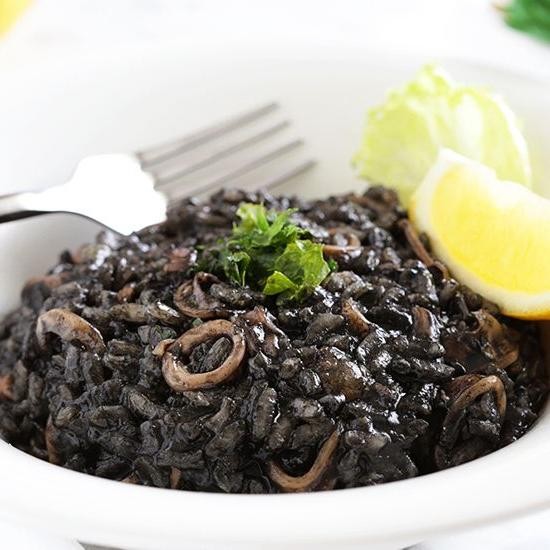
Hold onto your hats, foodies, because we’re diving fork-first into the mysterious, delicious depths of Black Risotto—a dish that’s as intriguing as it is Instagram-worthy. Who knew squid ink could turn dinner into a goth masterpiece?
Ingredients
- 1 cup Arborio rice (the only rice brave enough for this job)
- 4 cups chicken stock (homemade if you’re fancy, boxed if you’re human)
- 1 tbsp extra virgin olive oil (because regular olive oil is so last season)
- 1 small onion, finely diced (no one likes a chunky onion in their risotto)
- 2 cloves garlic, minced (more if you’re fighting vampires)
- 1/2 cup dry white wine (drink the rest while cooking—chef’s orders)
- 2 tbsp squid ink (the secret to its dark soul)
- 1/2 cup grated Parmesan cheese (the cheesier, the better)
- 2 tbsp unsalted butter (because everything’s better with butter)
- Salt to taste (but let’s be honest, you’ll taste and add anyway)
Instructions
- Heat the chicken stock in a saucepan over low heat. Keep it warm, like a good hug.
- In a large pan, heat the olive oil over medium heat. Add the onion and garlic, sautéing until they’re softer than your heart after a puppy video.
- Add the Arborio rice to the pan, stirring to coat each grain in oil. Toast for 2 minutes—think of it as giving the rice a tan.
- Pour in the white wine, stirring constantly until absorbed. This is where the magic starts.
- Begin adding the warm stock, one ladle at a time, stirring frequently. Wait until each addition is nearly absorbed before adding the next. Patience is key here.
- Once half the stock is incorporated, stir in the squid ink. Your risotto should now look like it’s ready for a villain’s dinner party.
- Continue adding stock until the rice is al dente and the mixture is creamy. This should take about 18 minutes total.
- Remove from heat and stir in the Parmesan and butter. This is the risotto’s curtain call.
- Season with salt if needed, but remember, Parmesan is salty, so taste first.
Rich, creamy, and with a depth of flavor that’ll have you questioning all your life choices, this Black Risotto is a showstopper. Serve it with a side of drama or a simple green salad—either way, you’re winning.
Octopus Salad
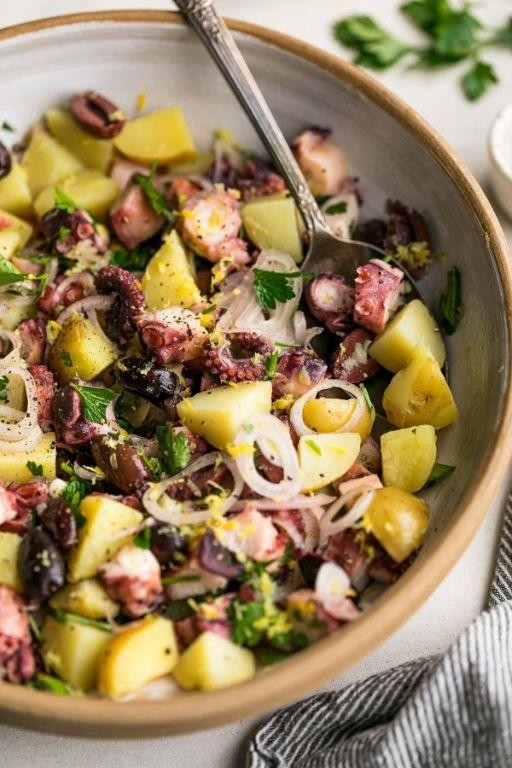
Craving something that’s a splash of the sea with a dash of drama? Our octopus salad is here to turn your meal into a maritime adventure, no sailor’s knot required.
Ingredients
- 1 lb octopus, cleaned (fresh or thawed, because nobody likes a rubbery surprise)
- 2 lemons, juiced (roll them first to get every last drop of sunshine)
- 1/4 cup extra virgin olive oil (the good stuff, because your salad deserves it)
- 1 cup cherry tomatoes, halved (like little bursts of summer)
- 1/2 red onion, thinly sliced (for that perfect crunch and a bit of attitude)
- 1/4 cup fresh parsley, chopped (because green is good)
- Salt to taste (but let’s be honest, you’re going to taste as you go)
Instructions
- Bring a large pot of salted water to a rolling boil. Think of the ocean, but hotter.
- Gently add the octopus to the boiling water. Reduce heat to a simmer and let it cook for about 45 minutes, or until tender. Tip: A fork should slide in easily, like butter on a hot knife.
- While the octopus is cooking, whisk together lemon juice and olive oil in a large bowl. This is your dressing, so make it zesty.
- Once cooked, remove the octopus from the water and let it cool slightly before chopping into bite-sized pieces. Tip: Letting it cool a bit makes it easier to handle, unless you enjoy finger gymnastics.
- Add the chopped octopus, cherry tomatoes, red onion, and parsley to the bowl with the dressing. Toss gently to combine. Tip: Use your hands for this step to feel like a true chef, but maybe wash them first.
- Season with salt to taste, give it one final toss, and let it sit for 10 minutes to let the flavors mingle. Think of it as a party where everyone gets along.
Bright, bold, and brimming with flavors that dance on your palate, this octopus salad is a celebration of the sea. Serve it on a bed of greens for an extra crunch or with crusty bread to soak up every last bit of that lemony dressing. Either way, it’s a dish that’s sure to make waves.
Peka with Veal
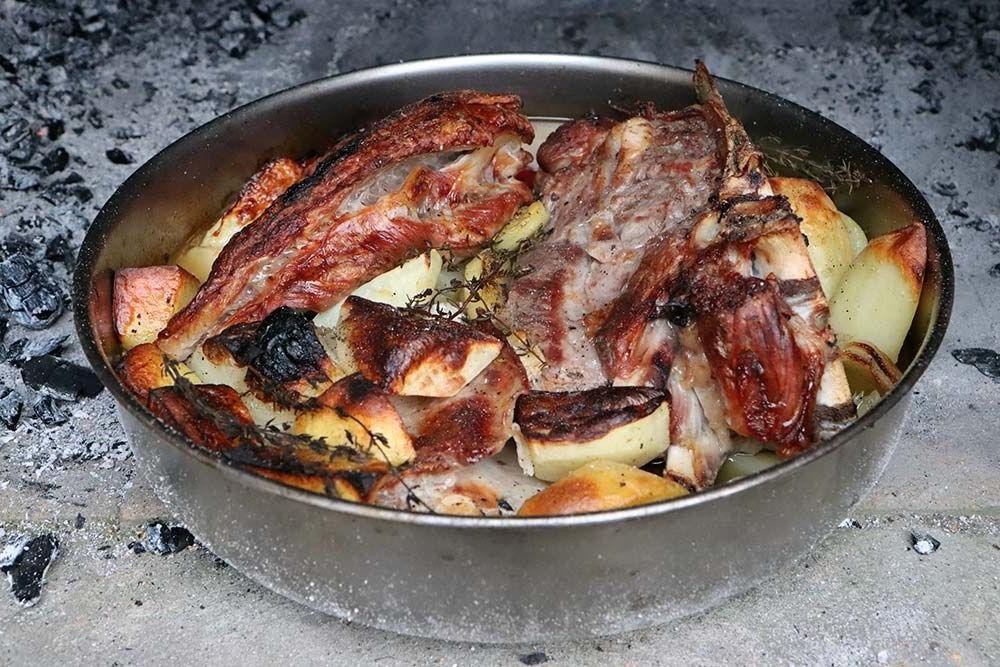
Mmm, let’s talk about Peka with Veal, a dish that’s as fun to make as it is to say. Imagine tender veal, slow-cooked to perfection under a bell-like dome, soaking up all those herby, garlicky goodness—yes, we’re in for a treat!
Ingredients
- 2 lbs veal, cubed (because bigger chunks mean juicier bites)
- 1/4 cup extra virgin olive oil (my go-to for that rich, fruity kick)
- 4 garlic cloves, minced (no such thing as too much garlic, right?)
- 1 tbsp rosemary, chopped (fresh is best, but dried will do in a pinch)
- 1 tbsp thyme leaves (because thyme flies when you’re having fun)
- 1 cup dry white wine (pick something you’d drink—it matters)
- Salt and pepper to taste (but be generous, life’s too short for bland food)
Instructions
- Preheat your oven to 350°F (175°C)—no peeking until it’s showtime!
- In a large bowl, toss the veal cubes with olive oil, garlic, rosemary, thyme, salt, and pepper. Massage those flavors in like you mean it.
- Transfer the veal to a peka or a heavy ovenproof dish. Pour the white wine over it—this is where the magic starts.
- Cover the dish tightly with a lid or aluminum foil. We’re trapping all those steamy, flavorful juices inside.
- Bake for 2 hours. Resist the urge to check; patience is key here.
- After 2 hours, remove the cover and bake for another 30 minutes to let the veal get that gorgeous golden-brown crust.
- Let it rest for 10 minutes before serving. Trust me, it’s worth the wait.
This Peka with Veal is a symphony of textures—tender meat, crispy edges, and a sauce that’s pure liquid gold. Serve it over a bed of creamy polenta or with crusty bread to sop up every last drop. Tempting, isn’t it?
Strukli
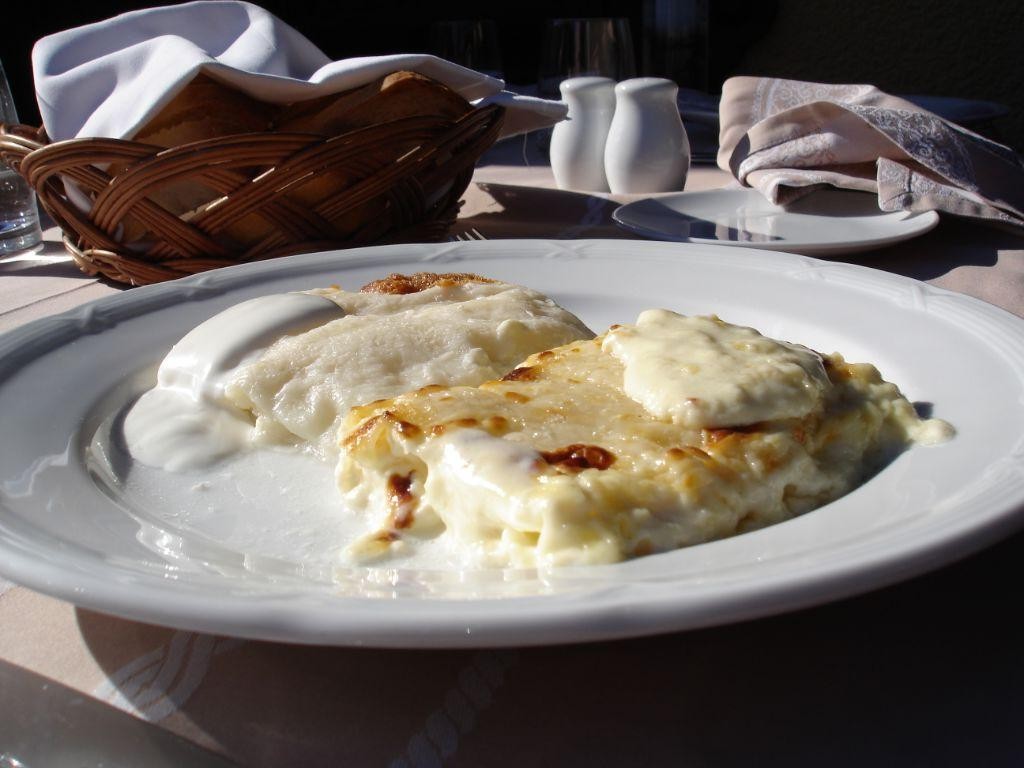
Oh, the joys of discovering a dish that’s as fun to make as it is to eat! Let me introduce you to Strukli, a delightful Croatian pastry that’s like a cozy blanket of dough hugging a creamy, cheesy filling. It’s the culinary equivalent of a warm hug on a chilly day, and trust me, your taste buds will thank you.
Ingredients
- 2 cups all-purpose flour (because, let’s be honest, it’s the backbone of most doughs)
- 1/2 cup sour cream (the secret to a tender, flaky crust)
- 1/2 cup unsalted butter, chilled and cubed (cold butter equals flaky layers, folks)
- 1 large egg (room temp, please—it mixes better)
- 1/2 tsp salt (just enough to make the flavors pop)
- 1 1/2 cups cottage cheese (go for the full-fat version for maximum creaminess)
- 1/2 cup heavy cream (because why not make it indulgent?)
- 1 egg yolk (for that golden, glossy finish)
Instructions
- In a large bowl, whisk together the flour and salt. Add the cubed butter and use your fingers to rub it into the flour until the mixture resembles coarse crumbs.
- Mix in the sour cream and egg until a dough forms. Tip: Don’t overwork the dough; it should just come together.
- Wrap the dough in plastic and chill for at least 1 hour. This rest period is crucial for easy rolling.
- Preheat your oven to 375°F (190°C) and line a baking sheet with parchment paper.
- On a floured surface, roll the dough into a large rectangle, about 1/8-inch thick. Tip: Keep the dough moving to prevent sticking.
- Spread the cottage cheese evenly over the dough, then drizzle with heavy cream.
- Carefully roll the dough into a log, then cut into 12 equal pieces. Place them on the prepared baking sheet.
- Brush the tops with egg yolk for that irresistible sheen. Tip: A silicone brush works best for even coverage.
- Bake for 25-30 minutes, or until golden brown and puffed.
Fresh out of the oven, Strukli is a masterpiece of contrasts—crispy on the outside, luxuriously soft and creamy within. Serve it warm with a drizzle of honey or a dollop of jam for a sweet twist, or keep it savory with a side of sour cream. Either way, it’s a showstopper.
Fritule

So, you’ve stumbled upon the magical world of Fritule, the little doughnut-like bites of joy that are about to become your new obsession. These Croatian delights are like the love child of a doughnut and a fritter, and they’re ridiculously easy to whip up for your next brunch or snack attack.
Ingredients
- 2 cups all-purpose flour (because, let’s face it, it’s the MVP of baking)
- 1/4 cup sugar (for that sweet, sweet happiness)
- 1 tsp active dry yeast (the tiny but mighty leavening hero)
- 1/2 cup warm milk (not too hot, or you’ll upset the yeast)
- 2 large eggs (room temp, please—they mix better that way)
- 1 tbsp rum (for a little kick, because why not?)
- 1/2 tsp salt (the unsung flavor enhancer)
- Zest of 1 lemon (for a zesty twist)
- Vegetable oil for frying (go for something neutral like canola)
Instructions
- In a small bowl, dissolve the yeast in warm milk and let it sit for 5 minutes until frothy. Patience is key here.
- In a large bowl, whisk together flour, sugar, and salt. Make a well in the center and add the eggs, rum, lemon zest, and yeast mixture. Stir until just combined. Tip: Overmixing is the enemy of fluffy Fritule.
- Cover the bowl with a clean towel and let the dough rise in a warm spot for 1 hour. It should double in size—like a proud baker’s achievement.
- Heat oil in a deep fryer or large pot to 350°F. Use a thermometer to keep the temperature steady. Tip: The right temp ensures a golden exterior without a greasy interior.
- Using a small spoon or your hands, drop tablespoon-sized portions of dough into the hot oil. Fry in batches to avoid overcrowding, about 2-3 minutes per side until golden brown. Tip: Watch them like a hawk—they go from golden to gone in seconds.
- Remove with a slotted spoon and drain on paper towels. Serve warm, dusted with powdered sugar or a drizzle of honey if you’re feeling fancy.
Vibrant and slightly crisp on the outside, these Fritule are pillowy soft inside with a hint of citrus and rum. Serve them stacked high on a platter, or sneak a few straight from the paper towel—we won’t judge.
Soparnik
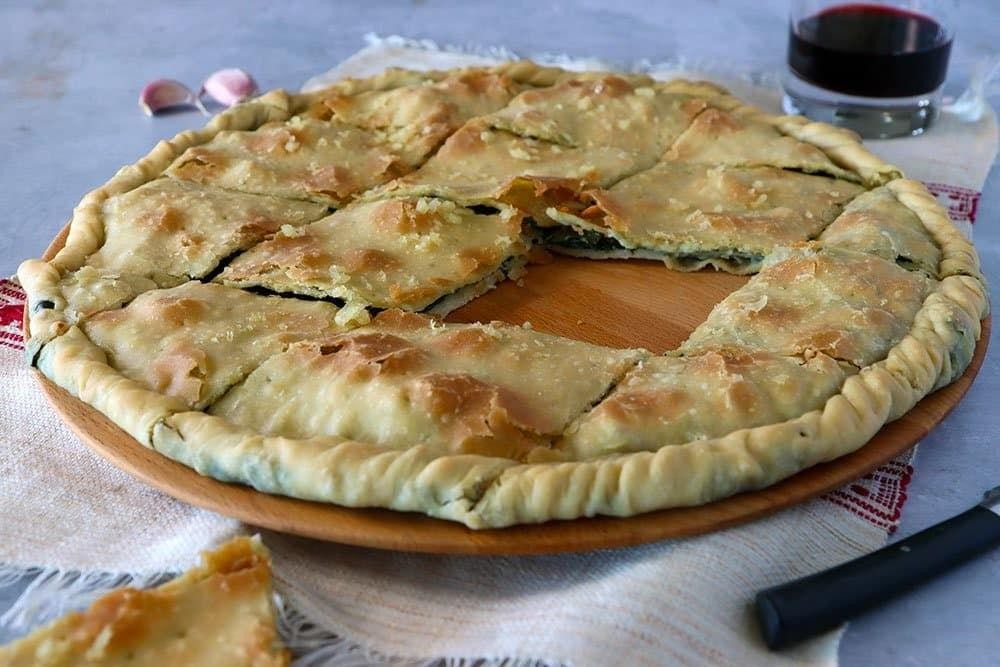
Craving something uniquely delicious yet surprisingly simple? Let me introduce you to Soparnik, a Croatian savory pie that’s like the love child of a flatbread and a spinach pie, ready to steal the spotlight at your next meal.
Ingredients
- 2 cups all-purpose flour (because, let’s face it, it’s the backbone of this beauty)
- 1/2 cup water (room temp, unless you’re into waiting)
- 1/4 cup extra virgin olive oil (my go-to for that golden, crispy crust)
- 1 lb fresh spinach (washed and chopped, because nobody likes sandy bites)
- 2 cloves garlic (minced, for that punch of flavor)
- 1 tsp salt (to make everything pop)
- 1/2 tsp black pepper (freshly ground, because we’re not savages)
Instructions
- In a large bowl, mix the flour and salt. Gradually add water and olive oil, kneading until the dough is smooth and elastic. Tip: If the dough sticks to your hands, a little more flour won’t hurt.
- Divide the dough into two equal parts. Roll each into a thin circle on a floured surface. Tip: Aim for about 1/8 inch thickness for the perfect bite.
- Preheat your oven to 375°F (190°C). Because patience is a virtue, especially in baking.
- In a bowl, mix the chopped spinach, minced garlic, and black pepper. Spread this mixture evenly over one dough circle, leaving a small border around the edges.
- Place the second dough circle on top, sealing the edges by pressing down with your fingers or a fork. Tip: A little water on the edges helps them stick together better.
- Bake for 25-30 minutes, or until the crust is golden and crispy. Let it cool for a few minutes before slicing.
This Soparnik comes out with a crispy exterior that gives way to a soft, flavorful spinach filling. Serve it warm, cut into wedges, and watch it disappear before your eyes. Perfect for a lazy brunch or as a standout side, it’s a dish that begs to be shared—or not, we won’t judge.
Krostule

Alright, let’s dive into the world of Krostule, those crispy, twisted delights that are like the love child of a doughnut and a pretzel, but with a personality all their own. Perfect for when you’re craving something sweet but want to keep things interesting.
Ingredients
- 2 cups all-purpose flour (because sometimes, simple is best)
- 3 large eggs (room temperature, please—they mix better that way)
- 1/4 cup granulated sugar (for that sweet, sweet happiness)
- 1/2 cup unsalted butter, melted (I go for the good stuff, no compromises)
- 1 tbsp vanilla extract (the real deal, not the imitation stuff)
- 1/2 tsp salt (to balance out the sweetness)
- Oil for frying (vegetable oil works wonders here)
- Powdered sugar for dusting (because everything’s better with a little snow on top)
Instructions
- In a large bowl, whisk together the flour and salt. This is where the magic starts.
- Add the eggs, one at a time, mixing well after each addition. Patience is key here.
- Stir in the granulated sugar and vanilla extract. Now it’s starting to smell like a bakery.
- Gradually add the melted butter, mixing until the dough comes together. It should be smooth but not sticky.
- Divide the dough into 4 equal parts. Cover and let it rest for 30 minutes. Yes, even dough needs a nap.
- On a floured surface, roll each part into a thin sheet, about 1/8 inch thick. Precision matters here.
- Cut the dough into strips, then twist each strip into a knot or your desired shape. Get creative!
- Heat the oil in a deep fryer or large pot to 350°F. A candy thermometer is your best friend here.
- Fry the Krostule in batches until golden brown, about 2 minutes per side. Don’t overcrowd the pot.
- Remove with a slotted spoon and drain on paper towels. Patience—they’re hot!
- While still warm, dust generously with powdered sugar. This is the crowning glory.
Yield: These Krostule are delightfully crispy on the outside with a tender, slightly chewy center. Serve them stacked high on a platter for maximum wow factor, or sneak a few straight from the cooling rack—I won’t tell.
Rakija

Get ready to dive into the world of Rakija, a fruit brandy that’s as bold and spirited as your aunt at a family reunion. This Balkan beauty is not just a drink; it’s a conversation starter, a tradition, and, let’s be honest, a bit of a flex when you serve it at parties.
Ingredients
- 5 lbs of ripe plums (the juicier, the better – think of them as the life of the party)
- 2 cups of sugar (because sweetness is non-negotiable)
- 1 gallon of water (filtered, unless you’re into the taste of your local water treatment plant)
- 1 packet of yeast (the magic maker that turns fruit into fun)
Instructions
- Wash the plums thoroughly, because nobody likes a dirty start to their brandy.
- Remove the pits from the plums – a tedious task, but think of it as meditation with a boozy reward.
- In a large pot, combine the plums, sugar, and water. Bring to a boil over medium heat, then simmer for 30 minutes, stirring occasionally. Tip: Keep an eye on it like it’s a toddler near a swimming pool.
- Let the mixture cool to room temperature. Patience is key here, unless you enjoy the smell of burnt sugar and regret.
- Add the yeast to the cooled mixture, stirring gently to combine. Cover with a clean cloth and let it ferment in a warm, dark place for 2 weeks. Tip: The warmer the spot, the faster the fermentation, but don’t rush perfection.
- After fermentation, strain the liquid through a cheesecloth into a clean container. Squeeze the cloth to get every last drop of that liquid gold.
- Distill the liquid according to your still’s instructions. Safety first – this isn’t the time for cowboy chemistry.
- Age the Rakija in a glass jar for at least 6 months. The longer it ages, the smoother it gets, much like your dance moves after a few sips.
Cheers to your homemade Rakija! This potent potion packs a punch with a fruity aroma and a warmth that spreads like gossip in a small town. Serve it chilled in small glasses to savor the flavor, or mix it into cocktails for a Balkan twist on your favorites.
Pag Cheese
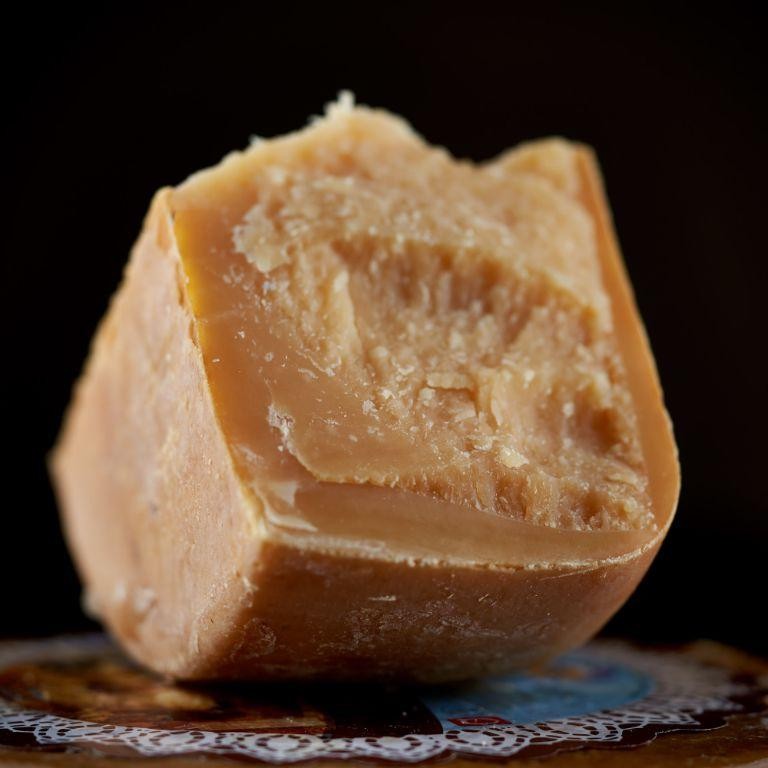
Unbelievably cheesy and irresistibly gooey, ‘Pag Cheese’ is the kind of dish that’ll have you forgetting your name after the first bite. It’s a simple yet sinful creation that combines the magic of melted cheese with a crispy, golden crust—perfect for those nights when only comfort food will do.
Ingredients
- 2 cups shredded mozzarella cheese (Because let’s be honest, more cheese is always better.)
- 1 cup grated Parmesan cheese (The sharper, the better for that flavor punch.)
- 1 tbsp extra virgin olive oil (My kitchen MVP for that perfect crisp.)
- 1/2 tsp garlic powder (For a little kick that whispers, ‘I’m here.’)
- 1/4 tsp black pepper (Freshly ground, because we’re not savages.)
Instructions
- Preheat your oven to 400°F (200°C) because we’re about to turn up the heat on this cheesy masterpiece.
- In a mixing bowl, combine the mozzarella and Parmesan cheeses, garlic powder, and black pepper. Mix them like you’re trying to solve the world’s problems—thoroughly.
- Heat the olive oil in a 10-inch oven-safe skillet over medium heat. Swirl it around to coat the bottom evenly—no cheese left behind!
- Spread the cheese mixture evenly in the skillet. Press it down gently with a spatula to ensure it’s compact and ready to crisp up beautifully.
- Cook for 2-3 minutes until the edges start to golden. This is your cue to get excited.
- Transfer the skillet to the preheated oven and bake for 5-7 minutes, or until the top is bubbly and golden brown. Watch it like a hawk to prevent a cheese tragedy.
- Remove from the oven and let it sit for 2 minutes. This brief pause is the ultimate test of your patience.
- Using a spatula, carefully lift the Pag Cheese from the skillet and transfer it to a cutting board. Slice it into wedges or tear it apart with your hands for a more rustic experience.
Lusciously crispy on the outside with a molten cheese center, Pag Cheese is a textural dream. Serve it alongside a tangy marinara for dipping, or go rogue and drizzle it with honey for a sweet and salty twist that’ll blow your mind.
Prsut

Alright, let’s dive into the world of Prsut, a dish that’s as fun to say as it is to eat! This dry-cured ham is a showstopper, perfect for when you want to impress without the stress. Think of it as the charcuterie board’s MVP, ready to score big at your next gathering.
Ingredients
- 1 lb Prsut (because more is always merrier, right?)
- 1 tbsp extra virgin olive oil (my kitchen’s liquid gold)
- 1/2 cup fresh figs, sliced (for a sweet surprise)
- 1/4 cup aged balsamic vinegar (the older, the bolder)
- A handful of arugula (for that peppery punch)
Instructions
- Start by thinly slicing the Prsut. Pro tip: A sharp knife is your best friend here to get those paper-thin slices.
- Drizzle the extra virgin olive oil over the Prsut slices. This not only adds flavor but also makes them glisten like morning dew.
- Arrange the sliced figs and arugula on a platter. The figs add a touch of sweetness, balancing the Prsut’s savory depth.
- Finish with a generous drizzle of aged balsamic vinegar. Its acidity cuts through the richness, tying all the flavors together beautifully.
So there you have it, a dish that’s a symphony of flavors and textures. The Prsut is salty and tender, the figs bring a juicy sweetness, and the arugula adds a crisp contrast. Serve it with a crusty baguette and watch it disappear before your eyes!
Kulen
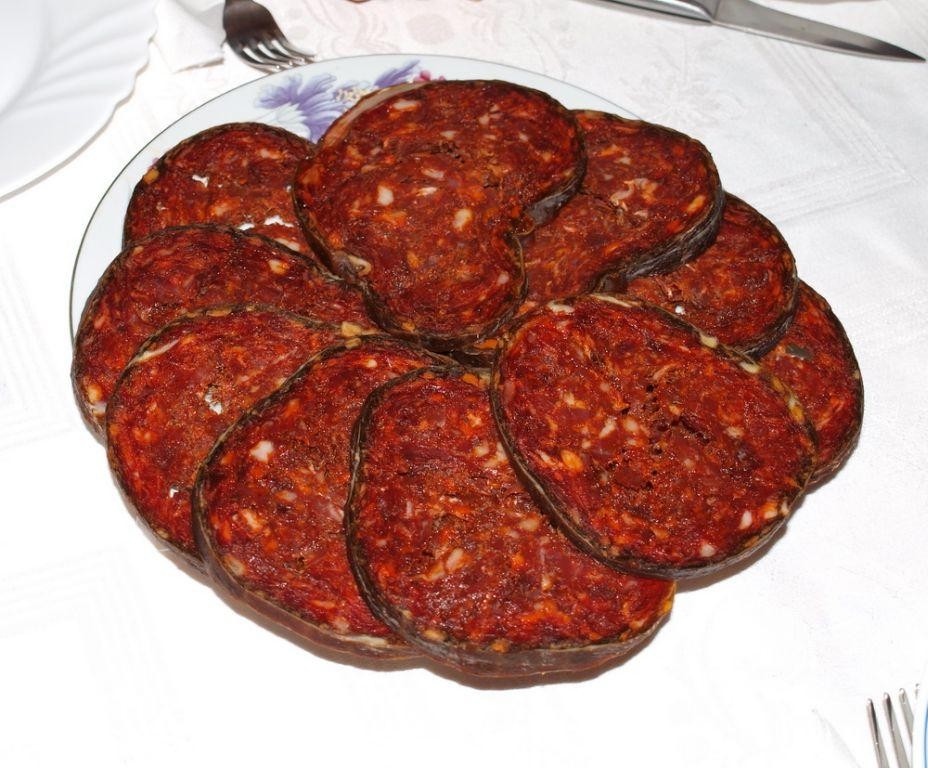
Buckle up, foodies! Today, we’re diving into the world of ‘Kulen’, a spicy, smoky sausage that’s like a flavor fireworks show in your mouth. Originating from the heart of Europe, this dish is a bold statement at any BBQ or charcuterie board.
Ingredients
- 2 lbs of ground pork (the fattier, the better for that juicy bite)
- 1 tbsp of smoked paprika (because we’re here for that smoky drama)
- 2 tsp of salt (just enough to make the flavors pop)
- 1 tsp of garlic powder (for that subtle kick)
- 1/2 tsp of cayenne pepper (adjust if you’re not into spicy surprises)
- Natural hog casings (pre-soaked, because nobody likes a tough casing)
Instructions
- In a large bowl, mix the ground pork with smoked paprika, salt, garlic powder, and cayenne pepper until well combined. Tip: Use your hands for the best mix—it’s messy but worth it.
- Cover the mixture and let it chill in the fridge for 24 hours. This marination is the secret handshake to flavor town.
- After chilling, stuff the mixture into the pre-soaked hog casings using a sausage stuffer. Tip: Keep the casings moist to avoid tearing.
- Twist the sausages into 6-inch links. Tip: A gentle touch here keeps them from bursting.
- Hang the sausages in a cool, dry place for 12 hours to dry. This step is like their beauty sleep before the big show.
- Smoke the sausages at 175°F for 4 hours, or until they reach an internal temperature of 160°F. Patience is key—low and slow wins the race.
Ready to impress? These Kulen sausages pack a punch with their smoky, spicy profile and a texture that’s delightfully snappy. Slice them up for a charcuterie board that’ll have everyone talking, or serve them whole at your next BBQ for a show-stopping main.
Brodet

Buckle up, foodies! Today we’re diving into the heartwarming, soul-soothing world of ‘Brodet’, a dish that’s like a hug in a bowl, perfect for those days when only comfort food will do.
Ingredients
- 2 lbs of mixed seafood (think shrimp, mussels, and white fish – the more variety, the merrier!)
- 1/4 cup extra virgin olive oil (my kitchen MVP for that rich, fruity depth)
- 1 large onion, diced (because every great dish starts with onion, right?)
- 3 garlic cloves, minced (the more, the merrier, I always say)
- 1 cup dry white wine (a splash for the pot, a splash for the chef – balance is key)
- 1 can (28 oz) crushed tomatoes (I go for San Marzano for their sweet, less acidic vibe)
- 1 tsp red pepper flakes (for that gentle kick that whispers ‘hello’)
- Salt to taste (but let’s be real, ‘to taste’ means ‘make it delicious’)
- Fresh parsley, chopped (for that pop of color and freshness)
- 1 loaf crusty bread (because what’s Brodet without something to sop up all that goodness?)
Instructions
- Heat the olive oil in a large pot over medium heat until it shimmers like a summer mirage.
- Add the diced onion and sauté until translucent, about 5 minutes, stirring occasionally to prevent any onion tantrums.
- Toss in the minced garlic and red pepper flakes, cooking for just 30 seconds until fragrant – your kitchen should smell like heaven now.
- Pour in the white wine, letting it simmer for 2 minutes to cook off the alcohol (we’re making dinner, not a cocktail).
- Add the crushed tomatoes and a pinch of salt, bringing the mixture to a gentle simmer. Let it bubble away for 10 minutes to marry the flavors.
- Gently nestle the mixed seafood into the pot, covering it with the tomato sauce. Cook for 5-7 minutes, just until the seafood is opaque and happy.
- Sprinkle with fresh parsley and serve immediately with slices of crusty bread on the side for maximum sauce absorption.
Final thoughts: This Brodet is a symphony of flavors – the seafood is tender, the sauce is rich with a hint of spice, and the bread? Well, it’s the unsung hero. Perfect for a cozy night in or impressing your in-laws with minimal effort.
Skradin Risotto
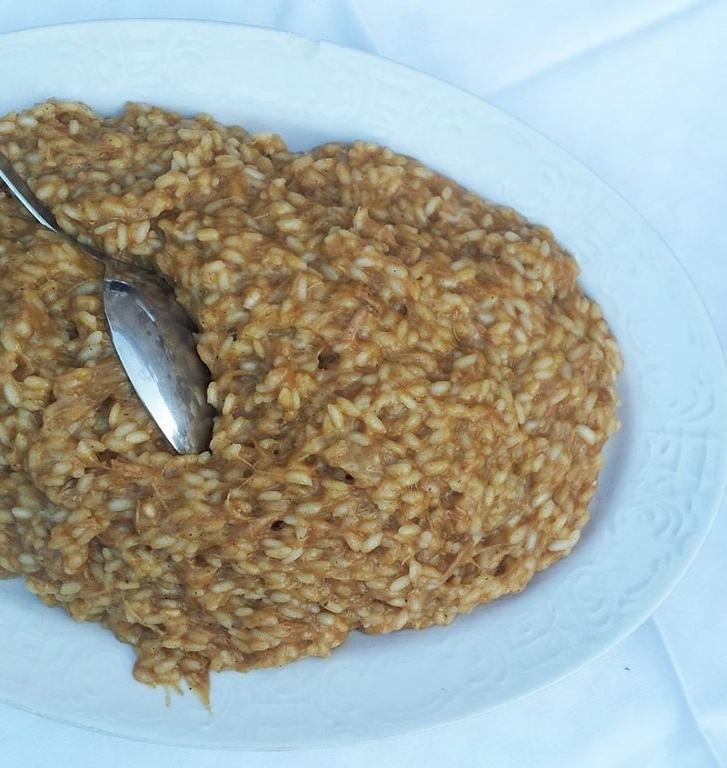
Buckle up, foodies! We’re diving fork-first into the creamy, dreamy world of Skradin Risotto, a dish so luxurious it’ll make your taste buds throw a party. And yes, it’s as fun to make as it is to eat—promise.
Ingredients
- 1 cup Arborio rice (the MVP of risottos)
- 4 cups chicken stock, kept warm (cold stock is a risotto’s worst enemy)
- 1/2 cup dry white wine (because the risotto deserves a little booze too)
- 1 small onion, finely chopped (no one likes a chunky onion surprise)
- 2 tbsp extra virgin olive oil (my kitchen staple)
- 1/2 cup grated Parmesan cheese (the more, the merrier)
- 2 tbsp unsalted butter (because butter makes everything better)
- Salt to taste (but let’s not go overboard)
Instructions
- Heat the olive oil in a large pan over medium heat. Add the onion and sauté until translucent, about 3 minutes. Tip: Don’t let the onion brown, or it’ll steal the show.
- Add the Arborio rice to the pan. Stir to coat each grain in oil and toast slightly, about 2 minutes. This step is crucial for that nutty flavor.
- Pour in the white wine and stir until fully absorbed. Tip: This is your chance to pretend you’re a fancy chef flambéing something.
- Begin adding the warm chicken stock, one ladle at a time, stirring constantly. Wait until each addition is nearly absorbed before adding the next. This patience-testing process takes about 18-20 minutes.
- Once the rice is al dente and the mixture is creamy, remove from heat. Stir in the butter and Parmesan cheese until melted and combined. Tip: This is the ‘make it or break it’ moment for creaminess.
- Season with salt if needed, but remember, Parmesan is salty.
Rich, creamy, and with just the right amount of chew, this Skradin Risotto is a texture lover’s dream. Serve it in a hollowed-out cheese wheel for that ‘I definitely meant to do that’ gourmet touch.
Brudet
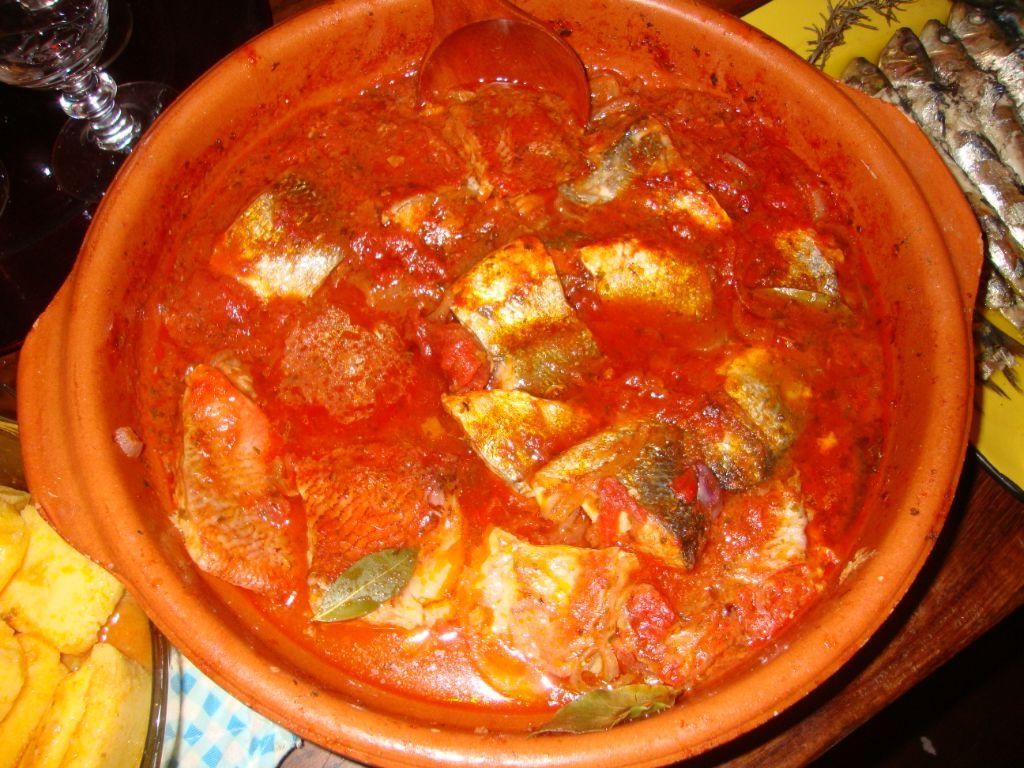
Who knew that a dish as humble as Brudet could pack such a punch of flavor? This Croatian seafood stew is like the ocean decided to throw a party in your mouth, and everyone’s invited—especially your taste buds!
Ingredients
- 2 tbsp extra virgin olive oil (my go-to for that rich, fruity depth)
- 1 large onion, diced (because size matters when it comes to flavor)
- 2 garlic cloves, minced (the more, the merrier, I say)
- 1 red bell pepper, sliced (for a sweet crunch)
- 1 lb mixed seafood (think shrimp, mussels, and white fish—the trio of the sea)
- 1 cup tomato sauce (homemade if you’re feeling fancy, store-bought if you’re human)
- 1/2 cup white wine (a splash for the pot, a sip for the chef)
- 1 tsp paprika (smoked, if you want to whisper sweet nothings to your dish)
- Salt to taste (but let’s be honest, you’ll add more than you think)
- Fresh parsley, chopped (for that pop of color and freshness)
Instructions
- Heat the olive oil in a large pot over medium heat until it shimmers like a mirage in the desert.
- Add the onion and garlic, sautéing until they’re softer than your favorite pillow, about 5 minutes.
- Toss in the red bell pepper, cooking for another 3 minutes until it’s just shy of a standing ovation.
- Introduce the seafood to the party, stirring gently to avoid any drama, and cook until it’s just opaque, about 2 minutes.
- Pour in the tomato sauce and white wine, then sprinkle the paprika like you’re seasoning the crown jewels. Let it simmer for 15 minutes, or until the sauce thickens to your liking.
- Season with salt, but remember, the sea already did half the job for you.
- Garnish with fresh parsley because we eat with our eyes first.
Dig into this Brudet and let the flavors transport you to the Adriatic coast. The tender seafood, bathed in a rich, tomatoey broth, pairs perfectly with a crusty piece of bread—because mopping up every last drop is not just encouraged, it’s required.
Gregada
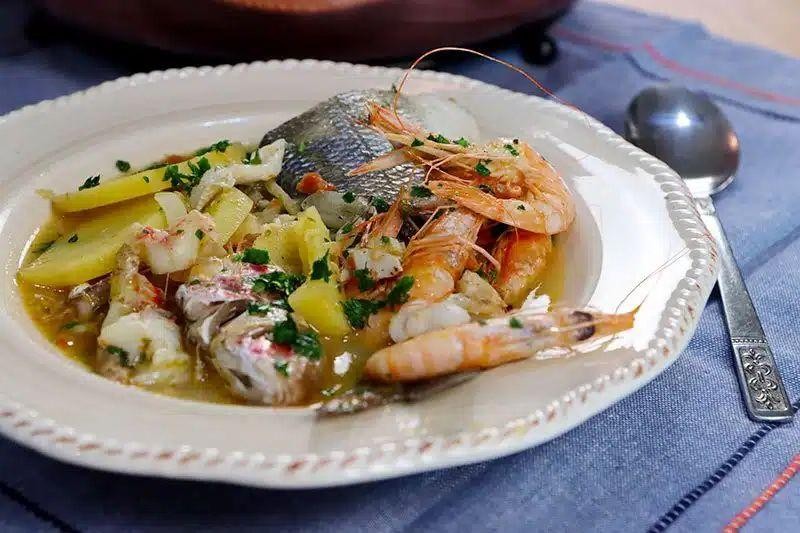
Oh, the joys of discovering a dish that’s as fun to say as it is to eat—Gregada! This hearty, comforting meal is like a warm hug from your grandma, if your grandma was a Portuguese chef with a knack for simple, flavorful ingredients.
Ingredients
- 2 lbs of beef chuck, cubed (because bigger chunks mean juicier bites)
- 1 large onion, diced (tears are optional but likely)
- 3 garlic cloves, minced (the more, the merrier, I say)
- 2 tbsp extra virgin olive oil (my kitchen staple)
- 1 cup dry white wine (a splash for the pot, a sip for the chef)
- 2 bay leaves (they’re the unsung heroes of flavor)
- Salt and pepper to taste (but let’s be generous, shall we?)
Instructions
- Heat the olive oil in a large pot over medium heat until it shimmers like a mirage in the desert.
- Add the diced onion and minced garlic, sautéing until they’re golden and fragrant, about 5 minutes. Tip: Stir occasionally to prevent any dramatic burn scenes.
- Toss in the beef cubes, browning them on all sides. This should take about 7 minutes. Tip: Don’t overcrowd the pot—give each piece its moment to shine.
- Pour in the white wine, scraping up any browned bits from the bottom of the pot. Those bits are flavor gold!
- Add the bay leaves, then season with salt and pepper. Stir to combine.
- Reduce the heat to low, cover, and let it simmer for 1.5 hours. Tip: Patience is key here; good things come to those who wait.
- After the time’s up, remove the bay leaves and adjust the seasoning if necessary.
Yum, the Gregada is ready to steal the show! The beef should be fork-tender, melting in your mouth with each bite, while the sauce is rich and deeply flavorful. Serve it over a bed of creamy mashed potatoes or with crusty bread to soak up every last drop of that delicious sauce.
Manestra
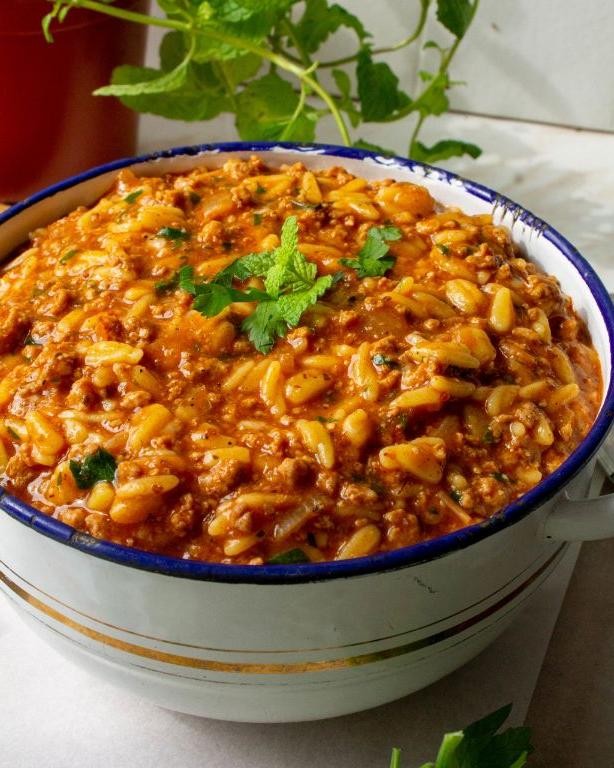
Ever heard of a dish that’s like a warm hug for your stomach? Let me introduce you to Manestra, a comforting Greek orzo dish that’s as fun to make as it is to eat. With its rich tomato base and tender pasta, it’s the culinary equivalent of a sunny day in the Mediterranean.
Ingredients
- 1 cup orzo pasta (because size does matter, and orzo is just the right bite)
- 2 tbsp extra virgin olive oil (my kitchen MVP for that golden, flavorful base)
- 1 small onion, finely chopped (tears are optional but likely)
- 2 garlic cloves, minced (the more, the merrier, I say)
- 1 can (14.5 oz) diced tomatoes (no need to be fancy, canned works wonders here)
- 2 cups chicken broth (homemade if you’re showing off, store-bought is totally fine)
- 1/2 tsp salt (because we’re seasoning, not snowing)
- 1/4 tsp black pepper (a little kick to keep things interesting)
- 1/4 cup grated Parmesan cheese (the cheesy cherry on top)
Instructions
- Heat the olive oil in a large pan over medium heat until it shimmers like a disco ball.
- Add the onion and sauté until it’s soft and translucent, about 5 minutes. No rushing—good things take time.
- Stir in the garlic and cook for 1 minute, just until it’s fragrant. Burnt garlic is a no-go.
- Pour in the diced tomatoes and their juices, letting the mixture simmer for 5 minutes to marry the flavors.
- Add the orzo, stirring to coat it in the tomato mixture. This is where the magic starts.
- Slowly pour in the chicken broth, then add the salt and pepper. Bring to a boil, then reduce the heat to low.
- Cover and simmer for 10 minutes, or until the orzo is al dente. Peek once or twice to stir and prevent sticking.
- Remove from heat and stir in the Parmesan cheese until it’s melted and creamy.
Kick back and enjoy your Manestra, where each spoonful offers a creamy texture with a tangy tomato punch. Serve it with a side of crusty bread to sop up every last bit, or top with a fried egg for breakfast with a twist. Either way, you’re in for a treat.
Rozata

Rozata, the creamy, dreamy cousin of flan, is here to steal the spotlight at your next dinner party. Rich, velvety, and with a caramel that’s just the right amount of cheeky, this dessert is like a hug in a ramekin.
Ingredients
- 1 cup sugar (because life’s too short for skimping on sweetness)
- 4 large eggs (room temp, please—they’re team players that way)
- 1 can (14 oz) sweetened condensed milk (the secret weapon)
- 2 cups whole milk (go big or go home)
- 1 tsp vanilla extract (the good stuff, none of that imitation nonsense)
Instructions
- Preheat your oven to 350°F—no peeking until it’s fully heated!
- In a medium saucepan, melt the sugar over medium heat, stirring constantly until it turns a deep amber color. This is your caramel, and patience here is key.
- Quickly pour the caramel into 6 ramekins, swirling to coat the bottoms evenly. Work fast—caramel waits for no one.
- In a large bowl, whisk the eggs until they’re just combined. Over-whisking is the enemy of smooth rozata.
- Add the sweetened condensed milk, whole milk, and vanilla extract to the eggs, whisking gently to marry the flavors without creating bubbles.
- Strain the mixture through a fine-mesh sieve into the caramel-lined ramekins to ensure your rozata is silky smooth.
- Place the ramekins in a large baking dish and fill the dish with hot water until it reaches halfway up the sides of the ramekins. This water bath is the spa treatment your rozata deserves.
- Bake for 45 minutes, or until the center is set but still slightly jiggly—like a good dance move.
- Remove from the oven and let cool to room temperature, then refrigerate for at least 4 hours, preferably overnight. Good things come to those who wait.
- To serve, run a knife around the edge of each ramekin and invert onto a plate with a confident flip. The caramel will cascade down the sides like a waterfall of deliciousness.
Golden and glorious, this rozata is a textural masterpiece—creamy, with a caramel that’s just the right shade of bold. Serve it with a side of ‘how did you make this?’ for maximum effect.
Conclusion
We hope this roundup of 20 Authentic Croatian Recipes has inspired you to bring a taste of Croatia into your kitchen. Each dish offers a unique blend of flavors and traditions, perfect for home cooks looking to explore new cuisines. Don’t forget to try these recipes, share your favorites in the comments, and pin this article on Pinterest to spread the deliciousness. Happy cooking!


